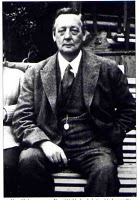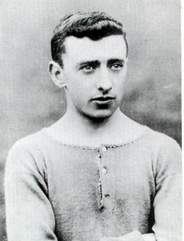David Calderhead was born on 19 June 1864, in Hurlford, East Ayrshire. After playing in junior football in Wishaw he joined Dumfries club Queen of the South Wanderers in 1881.

While there are obvious similarities in the name and they were based in Dumfries, Wanderers were a completely separate outfit to the Queen of the South who formed in 1919 (a quarter of a century after the demise of Wanderers following financial irregularities).
Calderhead, a centre half, was with the Dumfries club until near the decade’s end. The Scottish League was not formed until 1890 and with Wanderers not playing in the national league before the club’s demise, their biggest fixtures were in the Scottish Cup.
With a regionalised early round format, Wanderers played in many ties in the competition against locally based opponents, sometimes with eye brow raising results.
Among Wanderers biggest rivals were the 5th Kirkcudbrightshire Rifle Volunteers, (not to be confused with the 5th KOSB who merged with two other clubs in 1919 to become Queen of the South FC). Scottish Cup ties between the two were common place including chalking up a 7-7 draw on 8th Sept 1883. Moffat FC were another opponent (they also produced two full Scotland internationals in James Niven in 1885 and James Fraser in 1891). Moffat played Wanderers in the cup in 1887 drawing 4-4 and losing 7-4. In September 1888 Newton Stewart Athletic were beaten by Wanderers 14-2 before a few weeks later Falkirk were knocked out courtesy of a 10-2 score line.
Billy Houliston collected three full international Scotland caps while playing for Queen of the South. However, Houliston is neither the only nor the first player to collect a full international cap while playing for a Dumfries club. Calderhead played for Scotland v Ireland at Ibrox on 9th March 1889. With Scottish wins in the annual game against England then the norm, this was the era when English scouts came pouring into Scotland in their droves looking to bolster their club with Caledonian talent. Calderhead enjoyed a 7-0 win over the Irish and soon after joined the army of Scottish footballers playing professionally in England.
Calderhead signed for the side who claim to be the oldest professional League Club in the world, Notts County. Together they achieved a top league finish County have never surpassed, third in 1891. The club made the FA Cup final for the first time that season and as reported in the article on Blackburn Rovers manager, Thomas Mitchell, lost 3-1 in the Final after having beaten Rovers 7-1 a week before in the League at Blackburn. Calderhead returned to the final with County in 1894, this time played at Everton’s Goodison Park. En route to the final County achieved a decent consolation for the ‘91 final defeat by Blackburn; a 1-0 semi final win against Rovers.
County then caused Bolton Wanderers all sorts of problems on the way to a one sided 4-1 final win for Calderhead to get his hands on the trophy. Supporters no doubt found the victory all the sweeter with a third round 4-1 replay win against neighbours Nottingham Forest. The two FA Cup final appearances of the 1890s are the only two the Magpies have achieved to date in that competition.

This FA Cup win is notable as the first time by a club outside of England’s top tier after County had been relegated the season before. Calderhead’s side returned to the top flight in 1897 as Second Division champions.
In September 1900 Calderhead took up the managerial position at second flight Lincoln City (he also turned out for the Imps a couple of times). With stability marking a period of relative success, Lincoln stayed at this level throughout Calderhead’s stewardship with a best finish of a creditable fifth in 1902.
Among the players to play at Lincoln for Calderhead was a quick and skilful winger from Dumfries, Norrie Fairgray. When they first met, the manager who had played in Dumfries could not have imagined the impact the Doonhamer would have on his future.
In the FA Cup first round The Imps were drawn to play at home against promotion chasing Chelsea on 12th January 1907. A 2-2 draw kept them in the competition earning a visit to Stamford Bridge four days later. Calderhead’s side went through with Fairgray scoring the only goal of the contest. In May of the same year Calderhead was installed into the Chelsea hotseat to drive the promoted club’s top division challenge. Lincoln were relegated at the end of their first season after Calderhead’s departure.

(Norrie Fairgray at Chelsea)
With Fairgray making a similar journey to Stamford Bridge, the two were reunited again where the winger scored five goals in 85 Chelsea first team games. Angus Douglas left home town Lochmaben F.C. in 1907 to also join Chelsea where he was later awarded a full Scotland cap. After World War 1, Fairgray returned to Dumfries when he signed for fledgling Queen of the South in 1919. Douglas also survived the war but in the bitter cruelty that life can serve, he died in the 1918 flu pandemic that killed 50 million people worldwide.
Calderhead became known at The Bridge as ‘The Sphinx’ from his less than gregarious dealings with the press. On the field he built Chelsea into a very well supported club based on a reputation of attractive football and big name signings. The football may have been attractive but collecting trophies was a different matter. After relegation in 1910, 1911 was the year of an FA Cup semi final appearance against Newcastle. 1912 brought the return of top tier football with Chelsea on their way to establishing a bit of a reputation as something of a yo-yo club (changed days now of course with the Stamford Bridge roublefest).

Chelsea played in the 1915 FA Cup final at Old Trafford, the last before football adjournment in England due to World War 1. With infinitely more serious matters taking place in mainland Europe, the Final was a less than euphoric occasion for both sides. Chelsea’s star striker Vivian Woodward had missed the cup run due to war service. When available for the final he graciously refused to accept a playing spot saying it would be unfair to his team mates. Sheffield United won comfortably, 3-0.
When football reconvened in 1919/20, Calderhead’s side were in contention for a league and cup double. The third place league finish was the highest up to that point in time by any London club. Aston Villa ended the cup hopes 3-1 in the semi with the prospect of the final to be played at Chelsea’s ground.
Chelsea were relegated for a second time in 1923/24. After a succession of near misses and with Willie Ferguson on board, top division status was restored in 1929. With a lengthy end of season tour taking Chelsea to São Paulo, Calderhead’s team were also the first side to play there with shirt numbers. Locals responded awarding the nickname of ‘Los Numerados’.
With the biggest of a long string of headline grabbing signings on board, Hughie Gallacher, 1931-32 brought a further FA Cup semi final. Tommy Lang took Newcastle to a 2 goal lead and despite Gallacher pulling a goal back, Calderhead’s team were knocked out.
David Calderhead holds the record at Chelsea for managing games – a whopping 966 spread over 26 years (what Ken Bates makes of that is anyone’s guess). Calderhead left the job in June 1933 and died five years later in London at the age of 73. He had played in two FA Cup finals winning once and as manager appeared in another. As well as this he made it to the semi final on three other occasions managing Chelsea.
Calderhead’s son, David junior, played for Chelsea while Calderhead was manager and later emulated his father in that he also played for and managed Lincoln City.